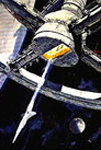-
 10,000 B.C.
10,000 B.C.Director Roland Emmerich is usually a stickler for realism (see: sending a computer virus via Macintosh to aliens in Independence Day). So we hate to inform him that woolly mammoths were not, in fact, used to build pyramids. Heck, woolly mammoths weren't even found in the desert. They wouldn't need to be woolly if that were the case. And there weren't any pyramids in Egypt until 2,500 B.C or so.
Movie Info | Trailers & Clips | Production Photos -

Gladiator
Movie Info | Trailers & Clips | Production Photos
Emperor Commodus was not the sniveling sister-obsessed creep portrayed in the movie. A violent alcoholic, sure, but not so whiny. He ruled ably for over a decade rather than ineptly for a couple months. He also didn't kill his father, Marcus Aurelius, who actually died of chickenpox. And instead of being killed in the gladiatorial arena, he was murdered in his bathtub. -

300
Movie Info | Trailers & Clips | Production Photos
Though this paean to ancient moral codes and modern physical training is based on the real Battle of Thermopylae, the film takes many stylistic liberties. The most obvious one being Persian king Xerxes was not an 8-foot-tall Cirque du Soleil reject. The Spartan council was made up of men over the age of 60, with no one as young as Theron (played by 37-year-old Dominic West). And the warriors of Sparta went into battle wearing bronze armor, not just leather Speedos. -

The Last Samurai
Movie Info | Trailers & Clips | Production Photos
The Japanese in the late 19th century did hire foreign advisers to modernize their army, but they were mostly French, not American. Ken Watanabe's character was based on the real Saigo Takamori who committed ritual suicide, or "seppuku," in defeat rather than in a volley of Gatling gun fire. Also, it's doubtful that a 40-something alcoholic Civil War vet, even one with great hair, would master the chopsticks much less the samurai sword. -

Apocalypto
Movie Info | Trailers & Clips | Production Photos
This one movie has given entire Anthropology departments migraines. Sure the Maya did have the odd human sacrifice but not to Kulkulkan, the Sun God, and only high-ranking captives taken in battle were killed. The conquistadors arriving at the end of the film made for unlikely saviors: an estimated 90% of indigenous American population was killed by smallpox from the infected Spanish pigs. -

Memoirs of a Geisha
Movie Info | Trailers & Clips | Production Photos
The geisha coming-of-age, called "mizuage," was really more of a makeover, where she changed her hairstyle and clothes. It didn't involve her getting... intimate with a client. In the climactic scene where Sayuri wows Gion patrons with her dancing prowess, her routine - which involves some platform shoes, fake snow, and a strobe light - seems more like a Studio 54 drag show than anything in pre-war Kyoto. -

Braveheart
Movie Info | Production Photos
Let's forget the fact that kilts weren't worn in Scotland until about 300 years after William Wallace's day and just do some simple math. According to the movie, Wallace's blue-eyed charm at the Battle of Falkirk was so overpowering, he seduced King Edward II's wife, Isabella of France, and the result of their affair was Edward III. But according to the history books, Isabella was three years old at the time of Falkirk, and Edward III was born seven years after Wallace died. -

Elizabeth: The Golden Age
Movie Info | Trailers & Clips | Production Photos
In 1585, when the movie takes place, Queen Elizabeth was 52 years old - Cate Blanchett was 36 when she shot the film - and was not being courted by suitors like Ivan the Terrible (who was dead by then). And though the movie has her rallying the troops at Tilbury astride a white steed in full armor with a sword, in fact she rode side saddle, carrying a baton. She was more of a regal majorette than Joan of Arc. -

The Patriot
Movie Info | Trailers & Clips | Production Photos
Revolutionary War figure Francis "The Swamp Fox" Marion was the basis for Mel Gibson's character, but he wasn't the forward-thinking family man they show in the flick. He was a slave owner who didn't get married (to his cousin) until after the war was over. Historians also say that he actively persecuted and murdered native Cherokees. Plus, the thrilling Battle of Guilford Court House where he vanquishes his British nemesis? In reality, the Americans lost that one. -

2001: A Space Odyssey
Movie Info | Trailers & Clips | Production Photos
According to this film, in year 2001 we would have had manned voyages to Jupiter, a battle of wits with a sentient computer, and a quantum leap in human evolution. Instead we got the Mir Space Station falling from the sky, Windows XP, and Freddy Got Fingered. Apparently the lesson here is that sometimes it's better when the movies get the facts all wrong.
what happens when poet practice degenerate, hand the microphone the keys swallowed by screen lock. bring it to climb, axe the sin, taxes comprehensive. when excellence becomes privations
Sunday, March 23, 2008
10 Least Accurate Movies - lifted from yahoo movies
Thursday, March 20, 2008
Concordia Grad Colloquium and Readings
The conference will take place on March 28 and March 29 in room H-762, and features graduate students from Concordia University and universities abroad. Please see the schedule below for more information.
We look forward to seeing you there,
English Graduate Colloquium Committee:
Bassel Atallah, Jennifer Baker, Jean-Francois Bernard, Lizzy Edwards, Megan Findlay, Caitlin Hartnett, Rachel Kyne, Jean-Marc Leblanc, Colin Martin, Valerie Medzalabanleth, Kathleen Ogden, Simon Reader, Katye Seip
------------------------------
CONCORDIA UNIVERSITY - DEPARTMENT OF ENGLISH
SIXTH ANNUAL GRADUATE COLLOQUIUM
ANATOMY OF PASSIONS
FRIDAY MARCH 28th
All panels held in Room H-762 (Hall Building)
PANEL 1: PENNING PERVERSION
Chair: Colin Martin
Psychopathic Feeling: Representations of Affect and Abnormality in Patricia Highsmith's The Talented Mr. Ripley
Mariiane Mays, (University of Manitoba)
Blood Runs Thicker Than Water: Perverse Humour(s) in Jean Stafford's The Mountain Lion
Humanization of the Rake: Eliza Haywood's Love in Excess
PANEL 2: INSIDE OUTSIDE UPSIDE DOWN 2:15pm – 3:30pm
Chair: Caitlin Hartnett
Philip Koch, (University of Manitoba)
Dark Matters: Architectural Resistances and the Productions of Space
David Rozon, (Concordia University)
Architectural Personalities: Deviance in Norman Mailer's The Armies of
the Night
Jennifer Baker, (Concordia University)
Small Sources of Power: 18th Century Service and the Economy of
Information
Professor Allan Pero (University of Western Ontario)
"A Corporal Radioscopy": Lacan, Badiou and Baroque Love
SATURDAY MARCH 29TH
All panels held in Room H-762
PANEL 3: EXECUTION OF FEELING
Chair: Kathleen Ogden
Stephanie Yorke, (University of New Brunswick)
Affect and Representation in Two Accounts of the Execution of Mary Stuart, or Mary Stuart: Beheaded, and Still Talking Out Both Sides of Her Mouth
Nathan Szymanski, (Concordia University)
Anti-Catharsis and the Passions in Marlowe's Edward II
Rachel Price, (Concordia University)
Stoic Agency in John Donne's View of Death
PANEL 4: MASSIVE MANIPULATIONS
Chair: Jean-Francois Bernard
Kate Trebuss, (University of Toronto)
Ordering the Elements of Affect: The Language of the Passions in
Paradise Lost
Chris Dilworth, (University of Montreal)
Drives and Affect: Motivation in the Theories of Butler and Sedgwick
Colin Martin, (Concordia University)
When Logic Fails: Nationalism, Marxism and a Place for Poesy
PANEL 5: SHOCK THERAPY: READING, REACTING AND REINTERPRETING
Chair: Valerie Medzalabanleth
Tine Appelman, (Concordia University)
Samuel Pepys: "all alone, like a man out of the world
Tracing the History of Trauma in Wilkie Collins' The Woman in White
Joan Wry, (McGill University)
Shelley's Mont Blanc: Romantic Affect and the Negative Sublime
Arts Café—201 Fairmount Ouest
Sunday, March 16, 2008
micheal taussig notes
no mic, no shoes, no service. mike problems solved by using the mic rather than standing apart from it.
anthropology of estrangement, lives in roland barthes, the third meaning lives on in what we're to hear today - filtered by taussig sketch in his field notebook filled working in columbia, july 2000.
the sketch shows pictures of cars out of alignment with the ruled page and a picture of a woman stitching a man into what appears to be a sleeping bag. it appears to have been drawn by a child, though apparently filled in with no small effort using watercolour paints.

july, 2000 in Medellin, Columbia. people sleeping in traffic tunnel because it was warm in the tunnel (according to my driver). a woman sews a man into a white nylon bag in a world of four million homeless - an epidemic caused by paramilitary activity and cows. no man's land, they have no land - and in this country all want land because all want cattle. even the president is a noted cattleman who, like others of his class, owns paramilitary to drive people off the land, that they can avoid being taxed on their cattle.
nylon cocoon in freeway canyon, inches between the cars and the people. what moth will emerge? a movement of enclosure writ at many levels as "freedom" implies homeless, no place. how is meaning subverted through barthes? square it away and then refute your square, as he, a restless thinker, does.
stifling deadly enclosures as a safety. stillness on a freeway. criticism a failed enterprise from its beginning: gap between meaning and picture, we have a silly understanding of understanding. this a drawing from life, real, but he draws it, makes an image but we have a fuzzy understanding of how the pictures we leave in give meaning.
carnival => barthes => surreal => benjamin
image and language take precedence. can reality out strip surreality? how strange is this normal? to be surreal is to go back and forth on this threshold between sleeping and waking. the region from which the surreal precision of poetry reports.
i see a young man waiting at an intersection. when the light goes red, he enters traffic, juggling flaming sticks with incredible skill. he circulates the intersection, juggling traffic with aplomb. animated, he juggles the sullen dummies in the cars - the tabla rasa for his surreal poetry, the way Breton's paris must have appeared when he juggled them also: as though an atom bomb has fallen in a fiery apparition amongst the sluggards. surreal is urban, through barthes' third meaning.
the third meaning is an interrogative meaning, living in film cells (stills) or panels from comic books. the drawing a reservoir of meaning. the french government attempted to return a preserved tattooed Maori head to new zealand for proper burial. but the minister of culture deems that the head may not leave france because it is a work of art and it is owned by france and is therefore french art and this man's head and thirty others of his brothers and sisters are artistic things belonging to the french people.
the head is not a body part. as french art, photos may no longer be taken of the head. drawings are permitted, as in a court room. in court, drawings - perhaps due to their temporal duration - fail to harm the living sacrifice the way photographic simulacra do.
...a mystery...
does the drawing, in its stillness, enter the realm of the sacred? bataille suggests cave paintings came after the hunt - made in celebration of the deceased - rather than before the hunt as previously assumed. celebration of the living rather than supplication to the immaterial for success in killing. bataille opposes greed, insecurity, survival of the fittest in favour of a wasteful, celebratory general economy.
perhaps barthes' study of signs tells us nothing, merely intellectualizes the image and ignores its imagicity. the power of image imaginary. but not so imaginary as incredible and shocking. the image a way to absorb shock, to mediate: image magic and the need to mark coexist in the words (as in taussig's sketch, written before the sketch was made) i swear i saw this.
to swear is to stand outside truth in order to insure truth. Bush aides will not testify under oath in the scandal over illegal influence peddling in the american judiciary and the Gonzales placing. they refuse to swear. foul language that can hurt the object of the foul language if misdirected. to be under oath could mean to turn the direction of the curse upon one's self, if the truth were not adequately dispensed by oath-makers.
to witness is needed only when no court available: but to whom do you swear? trying to heal a 17 year old from sorcery, taussig sang as he had seen other healers sing: but he faltered, unable to conjure the spirits. he put in real people to his mind, he imaged those who could help him sing and his imaging was good. seeing cannot be separated from singing, touching, but they differ from speaking. he struggled to write (speak) in his field journal of this healing song - too many "you's" appeared in the audience. he refigures them as spirits and can write.
all writers (especially diarists) write to spirits. i swear i saw this (witness) summons spirits. this is sketchy and ridiculous, despite Writing and Witnessing. all in this room are potential shamans, of freeway and traffic tunnels in negative capability; that curious state of the mastery of non-mastery.
regarding Primo Levi: writing the experience of Auschwitz as a weekly factory report. a factory built while he worked as camp labour at Auschwitz. can you witness (critically) your own witnessing? Levi realizes he writes a bunch of literature. "may your house fall apart - the curse, by the witness feeling the shame the just man feels at another's crime. does this shame disqualify the witness? it was the witness who survived, despite being (often) the least worthy person:
"We who survived the Camps are not true witnesses [...] we are those who, through prevarication, skill or luck, never touched bottom. Those who have, and who have seen the face of the Gorgon, did not return, or returned wordless."
taussig, through Levi, disagrees that Auschwitz lies outside language. the weekly factory report provided in _if this is a man_ creates a magical armature.
the taussig drawing? does it have a sacred quality? stupendous normality is what triggers the stupendous abnormality. levi no game but that of benjamin's story teller. forsake narrative for the still shot. remove the image from its succession: that removal is what barthes calls filmic. time stands still and is radically reorganized. this tension compresses time into space. allegorical reasoning stacks in the image, still despite the time taken crafting image, reading image. this is the eye of the hurricane.
taussig now reenacts a reenactment of a healing by a shaman who demonstrates how to heal a child of the evil eye (fright). the child is measured, the string is folded. the child is measured on another axis - the discrepancy indicates the length of the child's fright.
because children can see the other world, the spirit world, they are open to fright. to heal fright close the gap (length of fright) between those worlds and this. the result is a loss of fear and a conflation of the worlds. a third meaning.
QandA
Q - what do you gain making spirits of real people?
A - i started wondering what purpose field notebook drawings serve. does skill matter when drawing feels necessary? as anthropologists, we rely on truth of witnessing, i want to investigate that. as to why call it sacred and the implied demeaning of subjects this process could entail, i don't think it's romanticizing or exploitive but an adjunct or approach/tack to true witnessing. i swear i saw this invokes an external authority to underscore truth-telling and why wouldn't i include this?
there is no place in our urban language today for the human-spirit circuit except in metaphor of poetry, but in these other societies it is a triangle: spirits of living, dead, absent - that our language short circuits and thus stops meaning from working.
Q - re: singing
A - an essential part (with hallucinogens) without words to differ from speaking, making the song sounds (recordings with a curing fan as syncopated percussion, always shifting rhythms) different than speaking, it channels spiritual in so much of divinity throughout the world, even in contemporary pop songs. though i'm a great believer in language (i think it'll always get you there) this shadow of language can add a depth to the meaning of what you witness.
thinking is saturated with imagery.
talking is saturated with imagery.
but not really imaginary. drawings like this ask how picture-bound language is and how we take that for granted or how sometimes (Plato) we intensely fear it. this fear continues today, especially film and popular culture, when in conflict with 'real learning' - that is so suspect of what happens in an experiential environment.